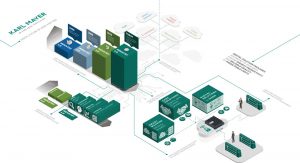
Christof Naier, president of the Business Unit Warp Knitting at the KARL MAYER Group, explains the digital future of warp knitting
TW Special Report
The history of industrial production has been shaped by on-going evolutionary changes. Following the discovery of steam engines in the 1800s, mass production began 100 years later, and the invention of the computer in the 1970s ushered in the Industry 3.0 era. In the intervening years, computers have become established in all areas of daily life. With the subsequent development of the Internet and cloud technology, the current Industry 4.0 era has come into being. What changes does the latest stage of human development bring for warp knitting? Ulrike Schlenker frome KARL MAYER’s Corporate Communication department asked Christof Naier, president of the KARL MAYER Group’s Warp Knitting Business Unit, about this.
Schlenker: What is the main difference between Industry 3.0 and 4.0?
Naier: Essentially, the two eras differ in their focus. While the most important themes for Industry 3.0 were hardware performance and networking, Industry 4.0 is primarily about data. The collection and collation of big data allows for complete transparency. In turn, transparency allows us to predict events in areas such as maintenance. For example, continuous monitoring can detect a rise in a motor’s operating temperature, and appropriately obtained data can then be used to localise the reason for the temperature increase and remedy it before the motor fails.
Event predictions also give us the opportunity to automate certain actions. Staying with the example of the overheating issue, for instance, the speed of the machine could be reduced automatically until the motor problem has been resolved.
Schlenker: How important are cloud solutions in unlocking opportunities such as these?

Naier: Thanks to WeChat, WhatsApp, PayPal & Alipay, Amazon and similar offerings, we already use a variety of cloud computing solutions in our everyday lives without even thinking about it. This technology is now finding its way into industrial use opening up new possibilities for us in areas such as after-sales support and maintenance for our customers’ machines. In this instance, we are building on three different cornerstones.
One key area is Care Solutions: Until now, customers have communicated with our team via smartphone, app or email when they needed support services. As a consequence, communication was often quite unstructured. We now have a newly developed platform that allows us to guide communication in the simplest and most targeted way. Thanks to networking solutions, we then already have all the necessary information about the machine, have access to the current log file, and can provide support in the form of initial measures.
As the second cornerstone, we provide customers with access to all the warp knitting-related knowledge that is available to KARL MAYER. In principle, this is about helping our customers with special functions that ensure maximum productivity and reproducible quality. We have grouped these topics together under the umbrella term “Smart Machine”.
Finally, the third cornerstone comprises our digital solutions, including collecting machine performance and efficiency data, matching evaluation tools, and helpful functions such as an alarm system for the machine. For example, the machine can automatically send a warning signal to the operator’s mobile phone informing them when a warp beam will soon need to be changed.
We also offer solutions for innovative design software. The new technology has made it very easy for our customers to develop patterns collaboratively with their global partners across international borders. This works in a similar way to how we work on Microsoft Teams or Zoom.
Thanks to our innovative k.ey Box, we guarantee the highest level of data and IT security for customers – including all subsidiaries and partners – when using any of these services.
Schlenker: This support concept minimises operational risks and maximises benefits for the customer. How far have you got with the implementation so far?
Naier: Our customers are already benefitting from numerous solutions. In the Smart Machine field, for example, they can load highly optimised lapping data from the cloud onto their machine using our Pattern Data System. These optimised movement sequences ensure that the machine will operate at the highest working speeds possible without affecting the quality of the product.
Our Care Solutions team is available 24/7 to provide support where needed. For first products, we already offer Care Solutions packages, which allow customers to benefit from fixed and – above all – plannable service costs. The aforementioned alarm system and evaluation tools are also already available. Using these tools, our customers can significantly increase their production efficiency.
KM.ON has developed a new planning tool for simple and transparent organisation of service measures. We are currently working at full speed on additional solutions.
November 2021




